#Arunachala Navamanimalai
Photo
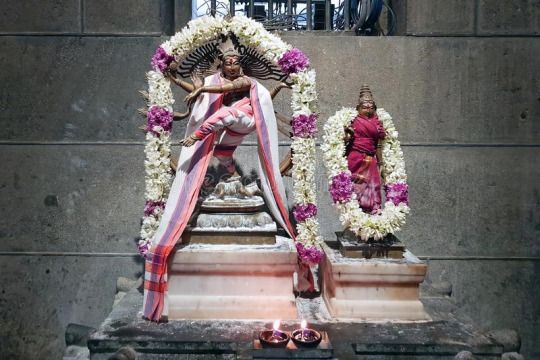
Sri Ramanasramam - The Matrubhuteswara Temple - Lord Siva dances in the form of Nataraja in front of the Mother, Sakti Devi
Arudra Darshanam is celebrated on the full moon night of Margazhi month of Tamil Calendar. This is observed on the thiruvadhirai nakshaththram (star) falling in this month.The festival marks the day of cosmic dance of Lord Shiva and it is celebrated in the form of Lord Nataraja. In Sri Ramanasramam, it is also celebrated in a grand manner. At around 4 am in 6 January 2023, the Nataraja idol in the Mathrubutheswara temple was anointed and decorated with flowers. This was followed by chanting of verses in praise of Nataraja followed by Aarthi...
******
Śrī Aruṇācala Navamaṇimālai - The Necklace of Nine Gems for Arunachala, Verse 1
🕉️
acalaṉē yāyiṉu maccavai taṉṉi
lacalaiyā mammaiyedi rāḍu — macala
vuruvilac catti yoḍuṅgiḍa vōṅgu
maruṇā calameṉ ḏṟaṟi.
Padacchēdam (words rearranged in natural prose order): acalaṉē āyiṉum, a-c-savai taṉṉil acalai ām ammai edir āḍum. acala uruvil a-c-satti oḍuṅgiḍa, ōṅgum aruṇācalam eṉḏṟu aṟi.
English translation:
Though actually one who is motionless, in that assembly hall he dances opposite mother, who is acalā. Know that when that śakti subsides back in the motionless form, Aruṇācalam is exalted.
Explanatory paraphrase:
Though [Lord Siva is] actually acalaṉ [one who is motionless, being the one immutable ground from which and in which everything else appears], in that assembly hall [of Cidambaram] he dances [in the form of Nataraja] opposite [the divine] mother, who is acalā [the consort of acalaṉ]. Know that when that śakti [the divine mother] subsides back in the motionless form [the fundamental form of Lord Siva], Aruṇācalam is exalted [that is, in the motionless form of Aruṇācalam, which rises high above all his other forms, Lord Siva shines exalted in his natural state].
Note :
The word Achalan means the motionless one and is a name of Lord Siva which is used to denote the fact that He is the immutable, Supreme Reality. The word Achalai means the consort of Achalan and is a name of Sakti, the Divine Mother.
Though He is motionless by nature, in Chidambaram Lord Siva had to dance in front of Sakti in order to bring Her frenzied dance to an end. But in the form of Arunachala Lord Siva remains ever motionless, and thus by the power of His mere stillness Sakti was irresistably attracted to Him and with great love she subsided in Him and became one with Him. Hence of all the forms of Lord Siva, Arunachala shines as the most exalted.
The words ‘ongum Arunachalam’ means ‘rises high’ or rises above others, and hence the words ‘ongum Arunachalam endru ari’ (know that He shines exalted as Arunachala) may also be taken to mean, know that Arunachala is superior (to Chidambaram)!
Source: Sri Arunachala Stuti Panchakam - Meaning: Sri Sadhu Om - Translation: Michael James

Arunachala - Photo by Markus Horlacher
#Bhagavan Sri Ramana Maharshi#Sri Arunachala Stuti Panchakam#Five Verses In Praise Of Arunachala#Arunachala Navamanimalai#AN v.1#The Necklace of Nine Gems for Arunachala#Chidambaram#Nataraja#cosmic dance#Arudra Darshanam#shakti#lord shiva#achala achalam#motionless immutable#achala devoid of thoughts#amala devoid of adjuncts#annihilation of the mind#nirmala pure#nischala motionless
25 notes
·
View notes
Photo

Sri Ramanasramam - Templo Matrubhuteswara - O Senhor Shiva dança na forma de Nataraja, em frente da Mãe Divina, Shakti Devi.
Arudra Darshanam é o festival que celebra a manifestação do Senhor Shiva como Nataraja, o Senhor da Dança Cósmica. É comemorado na noite de lua cheia do mês Margazhi do Calendário Tâmil, no dia em que coincidem a Lua Nova e a estrela Arudra -thiruvadhirai nakshathram- ou estrela do Senhor Shiva (Rudra). No Sri Ramanasramam, também é comemorado em grande estilo. Cerca das 4H00 de 6 de Janeiro de 2023, a imagem devovional de Nataraja no templo de Mathrubutheswara foi ungida e decorada com flores. Seguiu-se o canto de versos em louvor a Nataraja e o Aarthi...
🕉️
SRI ARUNACHALA NAVAMANIMALAI - O COLAR DE NOVE GEMAS PRECIOSAS PARA ARUNACHALA, VERSÍCULO 1
acalaṉē yāyiṉu maccavai taṉṉi
lacalaiyā mammaiyedi rāḍu — macala
vuruvilac catti yoḍuṅgiḍa vōṅgu
maruṇā calameṉ ḏṟaṟi.
Padacchēdam (separação das palavras): acalaṉē āyiṉum, a-c-savai taṉṉil acalai ām ammai edir āḍum. acala uruvil a-c-satti oḍuṅgiḍa, ōṅgum aruṇācalam eṉḏṟu aṟi.
Embora na verdade um que está imóvel, naquele salão de assembleia ele dança em frente da mãe, que é acalā. Saiba que quando essa śakti volta à forma imóvel, Aruṇācalam é exaltada.
Paráfrase explicativa:
Embora [o Senhor Shiva seja] na verdade acalaṉ [aquele que está imóvel, sendo o único fundamento imutável do qual e no qual tudo o mais aparece], naquele salão de assembleia de Chidambaram ele dança na forma de Nataraja em frente da divina mãe, que é acalā [a consorte de acalaṉ]. Saiba que quando essa śakti [a mãe divina] desaparece na forma imóvel [a forma fundamental do Senhor Shiva], Aruṇācalam é glorificada [isto é, na forma imóvel de Aruṇācalam, que se eleva acima de todas as suas outras formas, o Senhor Shiva brilha glorificado em seu estado natural].
Nota:
A palavra Achalan significa o imóvel e é um nome do Senhor Siva, que é usado para denotar o facto de que Ele é a imutável Realidade Suprema. A palavra Achala significa a consorte de Achalan e é um nome de Shakti, a Mãe Divina.
Embora Ele seja imóvel por natureza, em Chidambaram o Senhor Shiva teve que dançar na frente de Shakti para trazer a dança frenética de Shakti a um fim. Mas, na forma de Arunachala, o Senhor Shiva permanece sempre imóvel, e assim pelo poder da Sua mera quietude, Shakti foi irresistivelmente atraída por Ele e com muito amor ela se acalmou Nele e se tornou um com ele. Assim, de todas as formas do Senhor Shiva, Arunachala brilha como a mais gloriosa.
As palavras ongum Arunachalam significam ‘eleva-se alto’ ou eleva-se acima dos outros, e, portanto, as palavras ongum Arunachalam endru ari (saiba que Ele brilha glorificado como Arunachala) também podem significar, saiba que Arunachala é superior (a Chidambaram)!
Fonte: Sri Arunachala Stuti Panchakam - Significado: Sri Sadhu Om - Tradução: Michael James

Arunachala - Fotografia de Markus Horlacher
#Bhagavan Sri Ramana Maharshi#Michael James#Arunachala Stuti Panchakam#Cinco Poemas Em Louvor de Arunachala#Arunachala Navamanimalai#AN v.1#O Colar de Nove Gemas Preciosas para Arunachala#Chidambaram#Nataraja#Dança Cósmica#Arudra Darshanam#shakti#lord shiva#achala achalan#imóvel imutável#achala livre de pensamentos#amala livre de adjuntos#extinção do pensamento#aniquilação da mente#nirmala puro#nischala imóvel
4 notes
·
View notes
Photo

🕉️ 🔱 Om Namo Bhagavate Sri Arunachala Ramanaya 🔱 🕉️
The Paramount Importance of Self Attention, by Sri Sadhu Om, As recorded by Michael James
Part Three - Mountain Path: April-June 2012 - Excerpt
Note of 23rd December 1977
'How can we live a pure life in this world?'
Sadhu Om: Once a PWD inspector asked Bhagavan, 'How can we live a pure life in this world?' and he replied, 'You know the nattan-kal [a standing stone fixed at a road junction] we have in our villages [in the Madurai district]. See how many uses it has: villagers place their head-loads on it when they take rest, cows use it as a scratching-post, betel-chewers wipe their surplus chunnambu [lime-paste] on it, and others spit on it. We must live in this world like those nattan-kals.'
It is only in our view that Bhagavan appears to be compassionate. He actually has no compassion, because compassion entails the existence of others, and in his view there are no others. However, it is also true to say that he has perfect compassion, because he loves us all as himself, so he truly suffers with each of our sufferings. See the paradoxical nature of self-knowledge. It reconciles irreconcilable opposites. It makes having no compassion the same as having perfect compassion. Who can understand the state of self-knowledge?
'Love is our being, desire is our rising'. Love wants oneness, desire wants manyness. The movement of love is towards oneness, and of desire is towards manyness. Love is ever self-contented, desire is ever discontented. The fulfilment and perfect state of love is self-love (svatma-bhakti), which is the experience of absolute oneness, but desire can never be fulfilled.
Therefore all yogas or sādhanās aim towards oneness (which is sometimes called 'union' with God or the reality), and one-pointedness of mind is their vehicle. Sādhanā is a growth from desire to love, and self-love is the driving force behind this growth. The development of this growth towards love leads the aspirant to love just one God or one guru, which is the highest form of dualistic love, and the most effective aid to develop perfect self-love.
The guru shows the aspirant that the only means to achieve perfect self-love is self-attention. The aspirant therefore eagerly practises self-attention, but until his practice blossoms into true self-love, he continues clinging to his guru as the object of his love. His guru-bhakti is the stay and support that steadies and strengthens his growth towards self-love. This is the state that Bhagavan describes in verse 72 of Aksaramanamalai:
Arunāchala, protect [me] as a support to cling to so that I may not droop down like a tender creeper without support.
The aspirant's love for and faith in his guru constantly drives him back to self-attention, which is the path taught by the guru, and as a result he comes to be increasingly convinced that his own self is the true form of his guru. Thus his dualistic guru-bhakti dissolves naturally and smoothly into non-dualistic svātma-bhakti [love for self alone], which is his true nature. One-pointed fidelity to the guru and his teachings is therefore an essential ingredient in sādhanā, and it alone will yield the much longed for fruit of self-knowledge.
In Sri Arunāchala Stuti Panchakam Bhagavan teaches us the true nature of guru-bhakti. For example:
Arunāchala, when I took refuge in you as [my only] God, you completely annihilated me. (Aksaramanamalai verse 48)
... Is there any deficiency [or grievance] for me? ... Do whatever you wish, my beloved, only give me ever-increasing love for your two feet. (Navamanimalai verse 7)
What to say? Your will is my will, [and] that [alone] is happiness for me, lord of my life. (Patikam verse 2)
It is necessary to attempt to practise self-attention before one can possibly write commentaries on or translate Bhagavan's works. Only *--by repeatedly trying and failing can one begin to understand his teachings.
Take for instance the first sentence of Ulladu Narpadu: 'Except what is, does consciousness that is exist?' To a mind that is unaccustomed to the practice of self-attention this will seem a very abstract idea, because the first word ulladu ['what is' or existence] will immediately suggest the existence of things, so such a mind will understand this sentence to mean, 'Unless things exist, can they be known?' But Bhagavan is always pointing to self, so by the word ulladu he means nothing other than 'I', which is the sole reality, that which alone actually exists.
However this will be immediately understood only by those who are well-soaked in the practice of self-attention. Such a person will understand this sentence to mean, 'Other than what is [namely 'I'], can there be any consciousness of being [any awareness 'am']?' which they will understand as implying, 'My self-awareness [cit] is not other than my being [sat]'. It is so simple, but to ordinary people it seems abstract.
All scriptures and gurus aim at drawing our attention to ourselves, but as I said in the first part of The Path of Sri Ramana, up till now they have all started by conceding to our ignorant outlook of taking the ego to be real, and so they start their teaching from that perspective. But why not start from the source — from what is actually real? Bhagavan was a revolutionary, so he never conceded that our viewpoint was correct, but instead always pointed directly to the one selfevident reality, 'I am'.
Nowadays people have so many strange ideas about yoga, but in Ulladu Narpadu Bhagavan has given us a clear idea of what real yoga actually is.
It is to Muruganar that we owe the composition of Ulladu Narpadu. If it were not for him those twenty-one verses would have been ignored [a reference to the twenty-one stray verses composed by Bhagavan that Muruganar gathered together and asked him on 21st July 1928 to enlarge upon to form a work revealing the nature of reality and the means by which we can experience it, which prompted him to compose during the next three weeks Ulladu Narpadu, in which eventually only three of the original twenty-one verses were included (namely verses 16, 37 and 40), leaving the other eighteen to be relegated to the supplement (anubandham). Bhagavan was so confident of the power of his silence that he took no initiative to write or record his teachings, so it is to Muruganar that we owe the composition and compilation of the three principal sāstras [scriptural texts] containing Bhagavan's philosophy, namely Upadesa Undiyar, Ulladu Narpadu and Guru Vachaka Kovai.
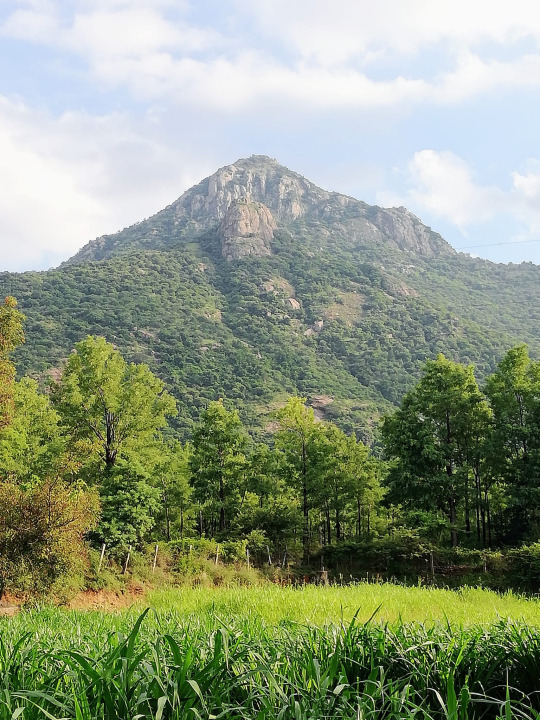
Arunachala - Unnamalai and Annamalai
Photo by G Anand Giri
#Bhagavan Sri Ramana Maharshi#Sadhu Om#Michael James#the paramount importance of self-attention#compassion love oneness#yoga union with God or the reality#guru-bhakti#self-attention#sat-cit-ananda#Sat Self#non-duality#our being is our attention#our sat is our cit#UN v.1#Ulladu Narpadu#our mere being is knowing
10 notes
·
View notes
Video
youtube
2021-08-16c Holland Park: Michael James discusses
Śrī Aruṇācala Navamaṇimālai - The Necklace of Nine Gems for Arunachala, Verse 6
🕉️
This video begins with Sadhu Om singing verse 6 of ஸ்ரீ அருணாசல நவமணிமாலை (Śrī Aruṇācala Navamaṇimālai), ‘The Necklace of Nine Gems for Arunachala’, and then Michael James explains and discusses the meaning and implications of it:
காமாரி யென்றுநீ யன்பரா லென்றுமே கதித்திடப் படுகின்றா
யாமாமெ யுனக்கிது வாமாவென் றையுறு மருணாச லேச்சுரனே
யாமாயி னெங்ஙனத் தீரனே சூரனே யாயினும் வல்லனங்கன்
காமாரி யாகுமுன் காலரண் சரண்புகு கருத்தினுட் புகவலனே.
kāmāri yeṉḏṟunī yaṉbarā leṉḏṟumē kathittiḍap paḍugiṉḏṟā
yāmāme yuṉakkidu vāmāveṉ ḏṟaiyuṟu maruṇāca lēśśuraṉē
yāmāyi ṉeṅṅaṉad dhīraṉē śūraṉē yāyiṉum vallaṉaṅgaṉ
kāmāri yāhumuṉ kālaraṇ śaraṇpuhu karuttiṉuṭ puhavalaṉē.
பதச்சேதம்: காமாரி என்று நீ அன்பரால் என்றுமே கதித்திடப்படுகின்றாய். ஆம், ஆம், மெய். உனக்கு இது ஆமா என்று ஐ உறும், அருணாசலேச்சுரனே. ஆம் ஆயின், எங்ஙன் அத் தீரனே சூரனே யாயினும் வல் அனங்கன் காமாரி ஆகும் உன் கால் அரண் சரண்புகு கருத்தினுள் புக வலனே?
Padacchēdam (word-separation): kāmāri eṉḏṟu nī aṉbarāl eṉḏṟumē kathittiḍappaḍugiṉḏṟāy. ām, ām, mey. uṉakku idu āmā eṉḏṟu ai uṟum, aruṇācalēśśuraṉē. ām āyiṉ, eṅṅaṉ a-d-dhīraṉē śūraṉē āyiṉum val aṉaṅgaṉ kāmāri-y-āhum uṉ kāl araṇ śaraṇpuhu karuttiṉuḷ puha valaṉē?
அன்வயம்: அருணாசலேச்சுரனே, காமாரி என்று நீ அன்பரால் என்றுமே கதித்திடப்படுகின்றாய். ஆம், ஆம், மெய். உனக்கு இது ஆமா என்று ஐ உறும். ஆம் ஆயின், ��ீரனே சூரனே யாயினும், எங்ஙன் அவ் வல் அனங்கன் காமாரி ஆகும் உன் கால் அரண் சரண்புகு கருத்தினுள் புக வலனே?
Anvayam (words rearranged in natural prose order): aruṇācalēśśuraṉē, kāmāri eṉḏṟu nī aṉbarāl eṉḏṟumē kathittiḍappaḍugiṉḏṟāy. ām, ām, mey. uṉakku idu āmā eṉḏṟu ai uṟum. ām āyiṉ, dhīraṉē śūraṉē āyiṉum, eṅṅaṉ a-v-val aṉaṅgaṉ kāmāri-y-āhum uṉ kāl araṇ śaraṇpuhu karuttiṉuḷ puha valaṉē?
🕉️
English translation:
O Aruṇācalēśvara, you are always described by devotees as the slayer of lust. Yes, yes, true. Doubt arises whether this is suitable for you. If it is suitable, how can that mighty bodiless one, though brave and valiant, enter a mind that takes refuge in the fortress of the feet of you, who are the slayer of lust?
🕉️
Explanatory paraphrase:
O Aruṇācalēśvara [God in the form of Aruṇācala], you are always described by devotees as Kāmāri [the slayer of kāma or lust] [1]. Yes, yes, true. [However] doubt arises whether this [name] is suitable for you. If it is suitable, how can that mighty Anaṅgan [Kāma, the ‘bodiless one’], though brave and valiant, enter a mind that takes refuge in the fortress of the feet of you, who are Kāmāri?
🕉️
While discussing the meaning, significance and implication of this verse Michael also refers to and discusses other passages from Bhagavan’s writings, namely:
Śrī Aruṇācala Navamaṇimālai:
Verse 4: https://youtu.be/Rlytp1BaS-Y
Verse 5: https://youtu.be/y2VMeKh5zAU
Uḷḷadu Nāṟpadu:
Verse 25: https://happinessofbeing.blogspot.com/2017/10/ulladu-narpadu-tamil-text.html#un25
Nāṉ Ār?:
Paragraph 10: https://www.happinessofbeing.com/nan_yar-5#para10
Paragraph 11: https://www.happinessofbeing.com/nan_yar-5#para11
On several occasions in the first half of this video Michael inadvertently refers to verses 4 and 5 of Śrī Aruṇācala Navamaṇimālai as verses 5 and 6 respectively.
An audio copy of this video can be listened to or downloaded from Sri Ramana Teachings podcast (https://ramanahou.podbean.com ): https://ramanahou.podbean.com/e/sri-arunachala-navamanimalai-verse-6
🕉️
[1] Kama is Cupid; his temptation of Siva while engaged in tapas (meditation), ended in his conflagration by a wrathful glance from Siva’s third eye. Out of pity for his disconsolate wife, Sati, Siva subsequently granted him continued existence in a subtle body.

ॐ Arunachalam ॐ
38:38 … when thoughts appear then and there, in the very place from which where they rise by vichara it's necessary to destroy them in the very place from which they rise.
That means as soon as the vasana arises - how do we kill it in the very place from which it rises as soon as it arises ? Only by clinging firmly to 'I am'.
The more we cling to ourselves the less we will be swayed by whatever vasanas arise.
So that is what Bhagavan refers to in this verse as taking refuge in the fortress of his feet.
So we need to cling firmly to self-attentiveness in order to overcome whatever vasanas may rise. And among all the vasanas that rise one type of vasana which is particularly strong and which we are particularly liable to be swayed by is this vasana of lust, the vasana of sexual desire. This is why Bhagavan composed this verse.
So this is a very nice prayer. If ever we find that we are troubled by thoughts of lust and we find that the desire is so strong that we're not even inclined to cling to self-attentiveness then the next best result is this prayer that Bhagavan has given us.
And in this prayer he's embedded a reminder what is the way to overcome this strong sexual desire. It's by taking refuge in his feet and taking refuge in his feet means clinging firmly to 'I am'.
So Bhagavan in this verse firstly he gives us a nice prayer and secondly he gives us a clue.
What is the efficacy of prayer ?
Prayer means we are aligning our will with the will of god. If we pray for anything that god doesn't want, that is not an appropriate prayer. That is, people who have come here to pray for the fulfillment of desire their prayers are not in accordance with the will of god.
But when we come to the spiritual path the only permissible prayers are prayers where we are praying for what Bhagavan wants for us. What Bhagavan wants for us is the annihilation of ego. So that is what all prayers should be aimed for, the annihilation of ego. So in order to annihilate ego we need to overcome all our vishaya-vasanas.
One particularly strong vishaya-vasana is this lust.
So in order to overcome this we must have the desire, the liking to overcome it.
So when we find our liking to enjoy that thoughts of sex is stronger than our liking to cling to 'I am' then prayer is appropriate because that is trying to realign our desire along with Bhagavan's desire. Bhagavan doesn't want us to be seeking happiness in petty external pleasures, he wants us to find the infinite happiness which is our own real nature which can be found only in our own heart.
So this prayer is a reminder to us.
We shouldn't allow ourselves to be troubled by thoughts of sex.
If we allow ourselves to be troubled when these vasanas rise, if we allow ourselves to be swayed by them, that is because we are failing to take refuge in the fortress of his feet.
So what is the solution ? To take refuge in the fortress of his feet by clinging to 'I am'.
And if our liking to cling to 'I am' at that moment is not strong enough then this prayer is a very great aid to us and a reminder to us of the importance of taking refuge on his feet clinging firmly to 'I am'.
So Bhagavan has given us prayers suitable for all the problems that we may face in the spiritual path. This is one particular problem that we all face soon if not at this moment in our life. At some moment in life we are always liable to be troubled by such thoughts. So when we're troubled by these thoughts our attention is going out towards things other than ourself and thereby diverting it away from self-attentiveness. In other words it's allowing ourselves to be attracted away from the fortress of his feet out into the world. So this is a reminder to us: we must return to the fortress of his feet and take refuge in him by clinging firmly to 'I am' because Bhagavan actually is that which is always shining in our heart as
'I am'.
Om Namo Bhagavate Sri Arunachala Ramanaya.
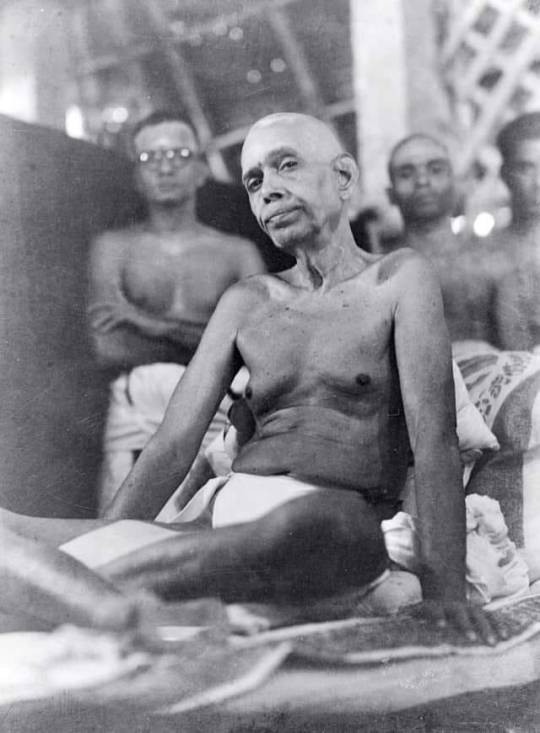
#Bhagavan Sri Ramana Maharshi#Michael James#Arunachala Stuti Panchakam#Five Verses In Praise Of Arunachala#Arunachala Navamanimalai#AN v.6#The Necklace of Nine Gems for Arunachala#inclinations or desires#visaya-vasanas#lust kama
15 notes
·
View notes
Video
youtube
2021-08-16b Holland Park: Michael James discusses
Śrī Aruṇācala Navamaṇimālai - The Necklace of Nine Gems for Arunachala, Verse 5
🕉️
This video begins with Sadhu Om singing verse 5 of ஸ்ரீ அருணாசல நவமணிமாலை (Śrī Aruṇācala Navamaṇimālai), ‘The Necklace of Nine Gems for Arunachala’, and then Michael James explains and discusses the meaning and implications of it:
சீரான சோணகிரி சிறக்க வாழுஞ்
சிற்சொருப னாமிறையே சிறிய னேன்றன்
பேரான பிழையெல்லாம் பொறுத்துக் காத்துப்
பின்னுமிவன் பாழிதனில் வீழா வண்ணங்
காரான கருணைவிழி கொடுப்பா யின்றேற்
கடும்பவத்தி னின்றுகரை யேற மாட்டே
னேரான துண்டோதாய் சிசுவுக் காற்று
நிகரற்ற நலனுக்கு நிகழ்த்து வாயே.
sīrāṉa śōṇagiri śiṟakka vāṙuñ
ciṯsorupa ṉāmiṟaiyē siṟiya ṉēṉḏṟaṉ
pērāṉa piṙaiyellām poṟuttuk kāttup
piṉṉumivaṉ pāṙidaṉil vīṙā vaṇṇaṅ
kārāṉa karuṇaiviṙi koḍuppā yiṉḏṟēṟ
kaḍumbhavatti ṉiṉḏṟukarai yēṟa māṭṭē
ṉērāṉa duṇḍōtāy śiśuvuk kāṯṟu
niharaṯṟa nalaṉukku nihaṙttu vāyē.
பதச்சேதம்: சீர் ஆன சோணகிரி சிறக்க வாழும் சித் சொருபன் ஆம் இறையே, சிறியனேன் தன் பேரான பிழை எல்லாம் பொறுத்து, காத்து பின்னும் இவன் பாழ் இதனில் வீழா வண்ணம் கார் ஆன கருணை விழி கொடுப்பாய். இன்றேல், கடும் பவத்தினின்று கரை ஏற மாட்டேன். நேர் ஆனது உண்டோ தாய் சிசுவுக்கு ஆற்றும் நிகர் அற்ற நலனுக்கு? நிகழ்த்துவாயே.
Padacchēdam (word-separation): sīr āṉa śōṇagiri śiṟakka vāṙum cit-sorupaṉ ām iṟaiyē, siṟiyaṉēṉ taṉ pērāṉa piṙai ellām poṟuttu, kāttu piṉṉum ivaṉ pāṙ idaṉil vīṙā vaṇṇam kār āṉa karuṇai viṙi koḍuppāy. iṉḏṟēl, kaḍum bhavattiṉiṉḏṟu karai ēṟa māṭṭēṉ. nēr āṉadu uṇḍō tāy śiśuvukku āṯṟu nihar aṯṟam nalaṉukku? nihaṙttuvāyē.
அன்வயம்: சீர் ஆன சோணகிரி சிறக்க வாழும் சித் சொருபன் ஆம் இறையே, சிறியனேன் தன் பேரான பிழை எல்லாம் பொறுத்து, பின்னும் இவன் பாழ் இதனில் வீழா வண்ணம் காத்து கார் ஆன கருணை விழி கொடுப்பாய். இன்றேல், கடும் பவத்தினின்று கரை ஏற மாட்டேன். தாய் சிசுவுக்கு ஆற்றும் நிகர் அற்ற நலனுக்கு நேர் ஆனது உண்டோ? நிகழ்த்துவாயே.
Anvayam (words rearranged in natural prose order): sīr āṉa śōṇagiri śiṟakka vāṙum cit-sorupaṉ ām iṟaiyē, siṟiyaṉēṉ taṉ pērāṉa piṙai ellām poṟuttu, piṉṉum ivaṉ pāṙ idaṉil vīṙā vaṇṇam kāttu kār āṉa karuṇai viṙi koḍuppāy. iṉḏṟēl, kaḍum bhavattiṉiṉḏṟu karai ēṟa māṭṭēṉ. tāy śiśuvukku āṯṟu nihar aṯṟam nalaṉukku nēr āṉadu uṇḍō? nihaṙttuvāyē.
English translation:
Lord who are one whose nature is pure awareness, shining gloriously as the sublime Śōṇagiri, bearing with all the great wrongs of myself, this petty person, and protecting in such a way that this one does not fall again in desolation, may you give a look of grace, which is a cloud. If not, I will not be able to rise up on the shore from cruel birth. Is there that which is comparable to the unequalled good that a mother does for a child? May you say.
Explanatory paraphrase:
Lord who are cit-svarūpaṉ [one whose nature is pure awareness], shining gloriously as the sublime Śōṇagiri [the Red Hill, Aruṇācala], bearing with [or forgiving] all the great wrongs of myself, this petty person, and protecting [me] in such a way that this one does not fall again in the desolation [of saṁsāra or worldly existence], may you give [me] [your] look of grace, which is [always showering abundantly like] [a rain-filled] cloud. If [you do] not, I will not be able to rise up on the shore from the cruel [ocean of repeated] birth [and death]. Tell [me], is there anything that is comparable to the unequalled good that a mother does for [her] child? [You are my mother and I am your child, so take care of me accordingly.]
✨
An MP3 audio copy of this video can be listened to or downloaded from Sri Ramana Teachings podcast (https://ramanahou.podbean.com ): https://ramanahou.podbean.com/e/sri-arunachala-navamanimalai-verse-5
🕉️

ॐ Om Namo Bhagavate Sri Arunachala Ramanaya ॐ

ॐ Arunachala Shiva ॐ - Photo by Bernd Kalidas Flory
#Bhagavan Sri Ramana Majharshi#Michael James#Sri Arunachala Stuti Panchakam#Arunachala Navamanimalai#AN v.5#The Necklace of Nine Gems for Arunachala#Arunachala#Sonagiri#Red Hill#pure consciousness#devotion#bhakti#prayer
9 notes
·
View notes
Video
youtube
2021-07-26a Kensington Gardens: Michael James discusses
Śrī Aruṇācala Navamaṇimālai - The Necklace of Nine Gems for Arunachala, Verse 1
🕉️
This video begins with Sadhu Om singing verse 1 of ஸ்ரீ அருணாசல நவமணிமாலை (Śrī Aruṇācala Navamaṇimālai), ‘The Necklace of Nine Gems for Arunachala’, and then Michael James explains and discusses the meaning and implications of it:
அசலனே யாயினு மச்சவை தன்னி
லசலையா மம்மையெதி ராடு — மசல
வுருவிலச் சத்தி யொடுங்கிட வோங்கு
மருணா சலமென் றறி.
acalaṉē yāyiṉu maccavai taṉṉi
lacalaiyā mammaiyedi rāḍu — macala
vuruvilac catti yoḍuṅgiḍa vōṅgu
maruṇā calameṉ ḏṟaṟi.
பதச்சேதம்: அசலனே ஆயினும், அச் சவை தன்னில் அசலை ஆம் அம்மை எதிர் ஆடும். அசல உருவில் அச் சத்தி ஒடுங்கிட, ஓங்கும் அருணாசலம் என்று அறி.
Padacchēdam (word-separation): acalaṉē āyiṉum, a-c-savai taṉṉil acalai ām ammai edir āḍum. acala uruvil a-c-satti oḍuṅgiḍa, ōṅgum aruṇācalam eṉḏṟu aṟi.
அன்வயம்: அசலனே ஆயினும், அச் சவை தன்னில் அசலை ஆம் அம்மை எதிர் ஆடும். அசல உருவில் அச் சத்தி ஒடுங்கிட, அருணாசலம் ஓங்கும் என்று அறி.
Anvayam (words rearranged in natural prose order): acalaṉē āyiṉum, a-c-savai taṉṉil acalai ām ammai edir āḍum. acala uruvil a-c-satti oḍuṅgiḍa, aruṇācalam ōṅgum eṉḏṟu aṟi.
English translation:
Though actually one who is motionless, in that assembly hall he dances opposite mother, who is acalā. Know that when that śakti subsides back in the motionless form, Aruṇācalam is exalted.
Explanatory paraphrase:
Though [Lord Siva is] actually acalaṉ [one who is motionless, being the one immutable ground from which and in which everything else appears], in that assembly hall [of Cidambaram] he dances [in the form of Nataraja] opposite [the divine] mother, who is acalā [the consort of acalaṉ]. Know that when that śakti [the divine mother] subsides back in the motionless form [the fundamental form of Lord Siva], Aruṇācalam is exalted [that is, in the motionless form of Aruṇācalam, which rises high above all his other forms, Lord Siva shines exalted in his natural state].
An MP3 audio copy of this video can be listened to or downloaded from Sri Ramana Teachings podcast (https://ramanahou.podbean.com ): https://ramanahou.podbean.com/e/sri-aru%e1%b9%87acala-navama%e1%b9%87imalai-verse-1
🕉️

Sri Ramanasramam - The Matrubhuteswara Temple - Lord Siva dances in the form of Nataraja in front of the Mother, Sakti Devi

#Bhagavan Sri Ramana Maharshi#Michael James#Sri Arunachala Stuti Panchakam#Five Verses In Praise Of Arunachala#Arunachala Navamanimalai#The Necklace of Nine Gems for Arunachala#AN v.1#Arunachala#Chidambaram#Nataraja#sakti devi#shakti#lord shiva#achala achalam#motionless immutable#achala devoid of thoughts#amala devoid of adjuncts#annihilation of the mind#nirmala pure#nischala motionless#Hridaya Heart Centre#hridaya kuhara madhye#Heart lotus
10 notes
·
View notes
Video
youtube
2021-08-16a Holland Park: Michael James discusses
Śrī Aruṇācala Navamaṇimālai - The Necklace of Nine Gems for Arunachala, Verse 4
🕉️
This video begins with Sadhu Om singing verse 4 of ஸ்ரீ அருணாசல நவமணிமாலை (Śrī Aruṇācala Navamaṇimālai), ‘The Necklace of Nine Gems for Arunachala’, and then Michael James explains and discusses the meaning and implications of it:
அண்ணா மலையுனை யெண்ணா னெனவெனை
யண்ணாந் தேங்கிட வெண்ணாதே
மண்ணா மலவுட லெண்ணா வகமென
மண்ணா மாய்ந்திட வொண்ணாதே
தண்ணா ரளிசெறி கண்ணா டொருகிறி
பண்ணா தென்னிரு கண்ணாளா
பெண்ணா ணலியுரு நண்ணா வொளியுரு
வண்ணா லென்னக நண்ணாயே.
aṇṇā malaiyuṉai yeṇṇā ṉeṉaveṉai
yaṇṇān dēṅgiḍa veṇṇādē
maṇṇā malavuḍa leṇṇā vahameṉa
maṇṇā māyndiḍa voṇṇādē
taṇṇā raḷiseṟi kaṇṇā ḍorukiṟi
paṇṇā deṉṉiru kaṇṇāḷā
peṇṇā ṇaliyuru naṇṇā voḷiyuru
vaṇṇā leṉṉaha naṇṇāyē.
பதச்சேதம்: அண்ணாமலை, உனை எண்ணான் என எனை அண்ணாந்து ஏங்கிட எண்ணாதே. மண் ஆம் மல உடல் எண்ணா அகம் என மண் ஆ மாய்ந்திட ஒண்ணாதே. தண் ஆர் அளி செறி கண் நாடு ஒரு கிறி பண்ணாது, என் இரு கண் ஆளா. பெண் ஆண் அலி உரு நண்ணா ஒளி உரு அண்ணால், என் அகம் நண்ணாயே.
Padacchēdam (word-separation): aṇṇāmalai, uṉai eṇṇāṉ eṉa eṉai aṇṇāndu ēṅgiḍa eṇṇādē. maṇ ām mala uḍal eṇṇā aham eṉa maṇ ā māyndiḍa oṇṇādē. taṇ ār aḷi seṟi kaṇ nāḍu oru kiṟi paṇṇādu, eṉ iru kaṇ āḷā. peṇ āṇ ali uru naṇṇā oḷi uru aṇṇāl, eṉ aham naṇṇāyē.
அன்வயம்: அண்ணாமலை, உனை எண்ணான் என எனை அண்ணாந்து ஏங்கிட எண்ணாதே. மண் ஆம் மல உடல் அகம் என எண்ணா மண் ஆ மாய்ந்திட ஒண்ணாதே. என் இரு கண் ஆளா, ஒரு கிறி பண்ணாது, தண் ஆர் அளி செறி கண் நாடு. பெண் ஆண் அலி உரு நண்ணா ஒளி உரு அண்ணால், என் அகம் நண்ணாயே.
Anvayam (words rearranged in natural prose order): aṇṇāmalai, uṉai eṇṇāṉ eṉa eṉai aṇṇāndu ēṅgiḍa eṇṇādē. maṇ ām mala uḍal aham eṉa eṇṇā maṇ ā māyndiḍa oṇṇādē. eṉ iru kaṇ āḷā, oru kiṟi paṇṇādu, taṇ ār aḷi seṟi kaṇ nāḍu. peṇ āṇ ali uru naṇṇā oḷi uru aṇṇāl, eṉ aham naṇṇāyē.
English translation:
Aṇṇāmalai, do not think me to pine away looking upwards like one who has not thought of you. It is not appropriate to perish as earth thinking that the filthy body, which is earth, is I. Beloved of my two eyes, without doing any trick, may cool love-filled eyes look. Lord, form of light unreached by forms of male, female and those who are neither, abide in my heart.
Explanatory paraphrase:
Aṇṇāmalai [Aruṇācala], do not think [of leaving] me to pine away looking upwards [with longing or in despair] like one who has not thought of you. It is not appropriate [for you to allow me] to perish as earth [or physical matter] thinking that the filthy body, which is earth, is I. Beloved of my two eyes, without playing any trick [or deception] [on me], may [your] cool love-filled eyes look [at me]. Lord, form of light [of pure awareness] unreached by [or transcending] [any differences such as] forms of male, female and those who are neither [wholly male nor wholly female], abide in my heart.
✨
While discussing the meaning, significance and implication of this verse Michael also refers to and discusses two other passages from Bhagavan’s writings, namely:
Śrī Aruṇācala Padigam:
Verse 10: https://happinessofbeing.blogspot.com/2019/11/how-to-merge-in-arunachala-like-river.html#c3866708280401270711
Upadēśa Undiyār:
Verse 24: https://happinessofbeing.blogspot.com/2017/09/upadesa-undiyar-tamil-text.html#uu24
Śrī Aruṇācala Akṣaramaṇamālai:
Verse 24:
Arunachala, embracing you, who kill devotees, hoisting a flag, how will I survive?
Explanatory paraphrase: Arunachala, embracing you, who [have vowed to] kill [your] devotees, hoisting a flag [to announce your intention to do so], how will I survive? [Or: having embraced you, how am I still living?]
Uḷḷadu Nāṟpadu:
Verse 4: https://happinessofbeing.blogspot.com/2017/10/ulladu-narpadu-tamil-text.html#un04
An MP3 audio copy of this video can be listened to or downloaded from Sri Ramana Teachings podcast (https://ramanahou.podbean.com ): https://ramanahou.podbean.com/e/sri-arunachala-navamanimalai-verse-4/
🕉️

#Bhagavan Sri Ramana Maharshi#Michael James#Sri Arunachala Stuti Panchakam#Five Verses In Praise Of Arunachala#Arunachala Navamanimalai#The Necklace of Nine Gems for Arunachala#AN v.4#Arunachala#supreme light of consciousness#sphurana 'I-I'#'I' 'I'
7 notes
·
View notes
Video
youtube
2021-07-26c Kensington Gardens: Michael James discusses
Śrī Aruṇācala Navamaṇimālai - The Necklace of Nine Gems for Arunachala, Verse 3
🕉️
This video begins with Sadhu Om singing verse 3 of ஸ்ரீ அருணாசல நவமணிமாலை ( Śrī Aruṇācala Navamaṇimālai), ‘The Necklace of Nine Gems for Arunachala’, and then Michael James explains and discusses the meaning and implications of it:
அருணா சலத்திலுறு கருணா கரப்பரம
னருணார விந்த பதமே
பொருணாடு சுற்றமொடு வருணாதி பற்றியுள
மருணாட லற்று நிதமுந்
தெருணா டுளத்தினின லருணாடி நிற்குமவ
ரிருணாச முற்று புவிமேற்
றருணா ருணக்கதிரி னருணாளு முற்றுசுக
வருணால யத்தி லிழிவார்.
aruṇā calattiluṟu karuṇā karapparama
ṉaruṇāra vinda padamē
poruṇāḍu suṯṟamoḍu varuṇādi paṯṟiyuḷa
maruṇāḍa laṯṟu nitamun
teruṇā ḍuḷattiṉiṉa laruṇāḍi niṯkumava
riruṇāca muṯṟu bhuvimēṯ
ṟaruṇā ruṇakkadiri ṉaruṇāḷu muṯṟucuka
varuṇāla yatti liṙivār.
பதச்சேதம்: அருணாசலத்தில் உறு கருணா ஆகர பரமன் அருண அரவிந்த பதமே, பொருள் நாடு சுற்றம் ஒடு வருண ஆதி பற்றி உளம் மருள் நாடல் அற்று நிதமும் தெருள் நாடு உளத்தினில், நல் அருள் நாடி நிற்கும் அவர் இருள் நாசம் உற்று புவி மேல், தருண அருண கதிரின் அருள் நாளும் உற்று சுக வருண ஆலயத்தில் இழிவார்.
Padacchēdam (word-separation): aruṇācalattil uṟu karuṇā ākara paramaṉ aruṇa aravinda padamē, poruḷ nāḍu suṯṟam oḍu varuṇa ādi paṯṟi uḷam maruḷ nāḍal aṯṟu nitamum teruḷ nāḍu uḷattiṉil, nal aruḷ nāḍi niṯkum avar iruḷ nāśam uṯṟu bhuvi mēl, taruṇa aruṇa kadiriṉ aruḷ nāḷum uṯṟu sukha varuṇa ālayattil iṙivār.
அன்வயம்: பொருள் நாடு சுற்றம் ஒடு வருண ஆதி பற்றி உளம் மருள் நாடல் அற்று நிதமும் தெருள் நாடு உளத்தினில், அருணாசலத்தில் உறு கருணா ஆகர பரமன் அருண அரவிந்த பதமே நல் அருள் நாடி நிற்கும் அவர் புவி மேல் இருள் நாசம் உற்று, தருண அருண கதிரின் அருள் நாளும் உற்று சுக வருண ஆலயத்தில் இழிவார்.
Anvayam (words rearranged in natural prose order): poruḷ nāḍu suṯṟam oḍu varuṇa ādi paṯṟi uḷam maruḷ nāḍal aṯṟu nitamum teruḷ nāḍu uḷattiṉil, aruṇācalattil uṟu karuṇā ākara paramaṉ aruṇa aravinda padamē nal aruḷ nāḍi niṯkum avar bhuvi mēl iruḷ nāśam uṯṟu, taruṇa aruṇa kadiriṉ aruḷ nāḷum uṯṟu sukha varuṇa ālayattil iṙivār.
English translation:
With a heart that always seeks clarity, being bereft of desiring and of the mental delusion of being attached to wealth, country, relatives, caste and so on, those who are steadfast in seeking sublime grace, the red lotus feet of the supreme Lord, the abode of grace, who dwells in Aruṇācalam, will subside in the ocean of bliss, achieving destruction of ignorance on earth, and always experiencing grace, like the rays of the rising sun.
Explanatory paraphrase:
With a heart that always seeks the clarity [of pure awareness], being bereft of desiring [anything else] and of the mental delusion of being attached to wealth, country, relatives, caste and so on, those [mature souls] who are steadfast in seeking the sublime grace of the red lotus feet of the supreme Lord, the abode [source, storehouse, abundance or bestower] of grace, who dwells in Aruṇācalam, will subside [and drown] in the ocean of bliss, achieving destruction of the darkness [of self-ignorance] [while living] on earth, and [thereby] always experiencing grace, [which shines brightly dispelling all darkness] like the rays of the rising sun.
✨
While discussing the meaning, significance and implication of this verse Michael also refers to and discusses another passage from Bhagavan’s writings, namely:
Śrī Aruṇācala Akṣaramaṇamālai: Verse 44: https://happinessofbeing.blogspot.com/2019/12/self-investigation-is-only-means-by.html#aamm44
An MP3 audio copy of this video can be listened to or downloaded from Sri Ramana Teachings podcast (https://ramanahou.podbean.com ): https://ramanahou.podbean.com/e/sri-arunachala-navamanimalai-verse-3


#Bhagavan Sri Ramana Maharshi#Michael James#Sri Arunachala Stuti Panchakam#Arunachala Navamanimalai#The Necklace of Nine Gems for Arunachala#AN v.3#Arunachala#desirelessness#detachment#surrender#renunciation#solitude#devotion#bhakti#association with the Self#sadguru
7 notes
·
View notes
Text
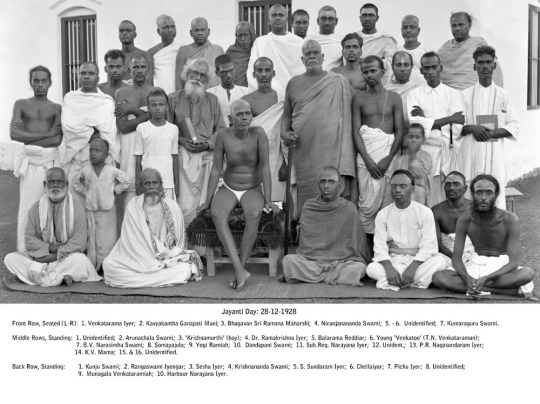
Fonte da imagem: David Godman Books
🕉️
SRI ARUNACHALA NAVAMANIMALAI - O COLAR DE NOVE GEMAS PRECIOSAS PARA ARUNACHALA, VERSÍCULO 9
ammaiyu mappaṉu māyeṉaip bhūmiyi lākkiyaḷit
tammahi māyaiye ṉāṙkaḍal vīṙnduyā ṉāṙndiḍumuṉ
ṉeṉmaṉa maṉṉi yiṙuttuṉ padatti liruttiṉaiyāl
ciṉmaya ṉāmaru ṇācala niṉṉaruṭ citrameṉṉē.
Padacchēdam (separação das palavras): ammai-y-um appaṉ-um āy eṉai bhūmiyil ākki aḷittu, a-m-mahi māyai eṉ āṙ kaḍal vīṙndu yāṉ āṙndiḍum muṉ, eṉ maṉam maṉṉi iṙuttu uṉ padattil iruttiṉai āl. ciṉmayaṉ ām aruṇācala niṉ aruḷ citram eṉṉē!
Me sustentando e cuidando de mim no mundo como mãe e pai, antes que eu me afundasse caindo no oceano profundo, ou seja, aquele māyā mundano, entrando em minha mente e me puxando, vós me fixastes a vossos pés. Aruṇācala, que sois um, composto de pura consciência, que maravilha de vossa graça!
Paráfrase explicativa:
Me sustentando e cuidando de mim no mundo como [minha] mãe e [meu] pai, antes que eu me afundasse no oceano profundo, ou seja, aquele māyā mundano [a ilusão de ser mãe ou pai], entrando em minha mente e [me] atraindo vós [me] fixastes aos vossos pés [ou no vosso estado]. Aruṇācala, que sois cinmayaṉ [um, composto de consciência pura], que maravilha de vossa graça [isto é]!
🕉️

Foto de Bernd Kalidas Flory - ॐ Arunachalam ॐ
🕉️
VIDEO: 2021-09-29c Kensington Gardens: Michael James fala sobre Śrī Aruṇācala Navamaṇimālai, versículo 9.
Este video começa com Sadhu Om a cantar o versículo 9 de ஸ்ரீ அருணாசல நவமணிமாலை ( Śrī Aruṇācala Navamaṇimālai), ‘O Colar de Nove Gemas Preciosas para Arunachala’
youtube
🕉️
#Bhagavan Sri Ramana Maharshi#Michael James#Arunachala Stuti Panchakam#Cinco Poemas Em Louvor de Arunachala#Arunachala Navamanimalai#AN v.9#O Colar de Nove Gemas Preciosas para Arunachala#pura consciência#cinmayaṉ
2 notes
·
View notes
Video
youtube
2021-07-26b Kensington Gardens: Michael James discusses
Śrī Aruṇācala Navamaṇimālai - The Necklace of Nine Gems for Arunachala, Verse 2
🕉️
This video begins with Sadhu Om singing verse 2 of ஸ்ரீ அருணாசல நவமணிமாலை ( Śrī Aruṇācala Navamaṇimālai), ‘The Necklace of Nine Gems for Arunachala’, and then Michael James explains and discusses the meaning and implications of it:
சத்திய சிற்சுக மன்றிப் பரவுயிர் சாரயிக்க
மர்த்தவத் தத்வ மசியரு ணப்பொரு ளாமசலத்
தர்த்தங் கனமது வாகுஞ்செவ் வாடக வாரொளியா
முத்தி நினைக்க வருளரு ணாசல முன்னிடவே.
sattiya ciṯsukha maṉḏṟip paravuyir sārayikka
martthavat tatva maciyaru ṇapporu ḷāmacalat
tartthaṅ ghaṉamadu vāhuñcev vāṭaka vāroḷiyā
mutti niṉaikka varuḷaru ṇācala muṉṉiḍavē.
பதச்சேதம்: சத்திய சித் சுகம் அன்றி பர உயிர் சார் அயிக்கம் அர்த்த அத் ‘தத் த்வம் அசி’ அருண பொருள் ஆம்; அசலத்து அர்த்தம் கனம் அது ஆகும்; செவ் ஆடக ஆர் ஒளி ஆம் முத்தி நினைக்க அருள் அருணாசலம் உன்னிடவே.
Padacchēdam (word-separation): sattiya-cit-sukham aṉḏṟi para-uyir-sār-ayikkam arttha a-t-‘tat tvam asi’ aruṇa poruḷ ām; acalattu arttham ghaṉam adu āhum; cev āṭaka ār oḷi ām mutti niṉaikka aruḷ aruṇācalam uṉṉiḍavē.
அன்வயம்: செவ் ஆடக ஆர் ஒளி ஆம் முத்தி நினைக்க அருள் அருணாசலம் உன்னிடவே, அருண பொருள் சத்திய சித் சுகம் அன்றி பர உயிர் சார் அயிக்கம் அர்த்த அத் ‘தத் த்வம் அசி’ ஆம்; அசலத்து அர்த்தம் கனம் அது ஆகும்.
Anvayam (words rearranged in natural prose order): cev āṭaka ār oḷi ām mutti niṉaikka aruḷ aruṇācalam uṉṉiḍavē, aruṇa poruḷ sattiya-cit-sukham aṉḏṟi para-uyir-sār-ayikkam arttha a-t-‘tat tvam asi’ ām; acalattu arttham ghaṉam adu āhum.
English translation:
When one carefully considers Aruṇācalam, which is red gold pervading light, and which bestows liberation when one thinks, besides existence-awareness-happiness, that ‘That you are’, the meaning of which is the intimate oneness of the Supreme and the soul, is the meaning of aruṇa; the meaning of acalam is completeness.
Explanatory paraphrase:
When one carefully considers [the meaning of the name] Aruṇācalam, which is the all-pervading light [of pure awareness], [whose bright lustre is like] red gold, and which bestows mukti [liberation] when one thinks [of it], (it is revealed that) the meaning of aruṇa [which consists of three syllables, namely a-ru-ṇa] is not only satya-cit-sukham [Existence-Awareness-Happiness] but also that [mahāvākya (great declaration)] ‘tat tvam asi’ [That you are], the meaning of which is para-uyir-sār-ayikkam [the intimate oneness of the Supreme and the soul, also known as jīva-brahma-aikya]; and the meaning of acalam is ghanam [completeness, density, firmness or abundance].
✨
While discussing the meaning, significance and implication of this verse Michael also refers to and discusses two other passages from Bhagavan’s writings, namely:
Upadēśa Undiyār:
Verse 24: https://happinessofbeing.blogspot.com/2017/09/upadesa-undiyar-tamil-text.html#uu24
Śrī Aruṇācala Akṣaramaṇamālai:
Verse 1: https://happinessofbeing.blogspot.com/2017/03/what-is-remembering-lord-or-remembrance.html#aamm001
An MP3 audio copy of this video can be listened to or downloaded from Sri Ramana Teachings podcast (https://ramanahou.podbean.com ): https://ramanahou.podbean.com/e/sri-arunachala-navamanimalai-verse-2
🕉️
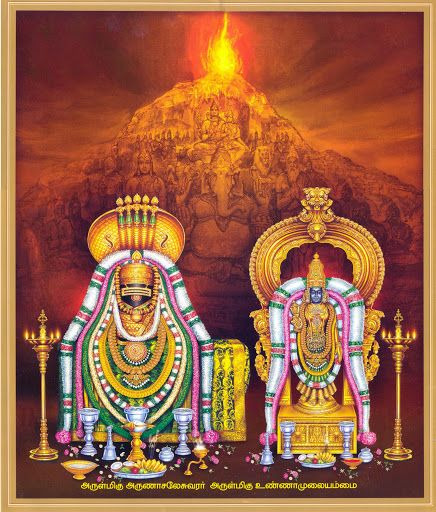
#Bhagavan Sri Ramana Maharshi#Michael James#Sri Arunachala Stuti Panchakam#Five Verses In Praise Of Arunachala#Arunachala Navamanimalai#The Necklace of Nine Gems for Arunachala#AN v.2#Arunachala#aruna#a-ru-na#existence-awareness-happiness#existence-consciousness-bliss#sat-chit-ananda#sat-cit-ananda#satya-cit-sukham#That you are#That Thou Art#Tat-Tvam-Asi#para-uyir-sar-ayikkam#oneness of Supreme and soul#mukti liberation#jiva-brahma-aikya#achala achalam#motionless immutable#acalam is ghanam#completeness density firmness abundance
4 notes
·
View notes
Photo

SriVidhya Devi Sairam Art - Maharishi Ramanar
A divine painting of a Great Indian Saint Ramana Maharishi, which gives Peace to the heart and soul.
Om Namo Bhagavate Sri Arunachala Ramanaya
🕉️
SRI ARUNACHALA NAVAMANIMALAI - O COLAR DE NOVE GEMAS PRECIOSAS PARA ARUNACHALA, VERSÍCULO 4
aṇṇā malaiyuṉai yeṇṇā ṉeṉaveṉai
yaṇṇān dēṅgiḍa veṇṇādē
maṇṇā malavuḍa leṇṇā vahameṉa
maṇṇā māyndiḍa voṇṇādē
taṇṇā raḷiseṟi kaṇṇā ḍorukiṟi
paṇṇā deṉṉiru kaṇṇāḷā
peṇṇā ṇaliyuru naṇṇā voḷiyuru
vaṇṇā leṉṉaha naṇṇāyē.
Padacchēdam (separação das palavras): aṇṇāmalai, uṉai eṇṇāṉ eṉa eṉai aṇṇāndu ēṅgiḍa eṇṇādē. maṇ ām mala uḍal eṇṇā aham eṉa maṇ ā māyndiḍa oṇṇādē. taṇ ār aḷi seṟi kaṇ nāḍu oru kiṟi paṇṇādu, eṉ iru kaṇ āḷā. peṇ āṇ ali uru naṇṇā oḷi uru aṇṇāl, eṉ aham naṇṇāyē.
Aṇṇāmalai, não pense em mim a definhar olhando para cima como alguém que não pensou em vós. Não é apropriado perecer como terra pensando que o corpo impuro, que é terra, é "eu". Amado de meus dois olhos, sem nenhuma partida, possam olhos cheios de serenidade e amor olhar. Senhor, forma de luz não alcançada por formas de masculino, feminino e daquelas que não são nem uma nem outra, habite em meu coração.
Paráfrase explicativa:
Aṇṇāmalai [Aruṇācala], não pense [em me deixar] definhar olhando para cima [com anseio ou em desespero] como alguém que não pensou em vós. Não é apropriado [que vós me permitais] perecer como terra [ou matéria física] pensando que o corpo impuro, que é terra, é "eu". Amado de meus dois olhos, sem [me] pregar nenhuma partida [ou dececionar], que [seus] olhos serenos cheios de amor olhem [para mim]. Senhor, forma de luz [de consciência pura] não alcançada por [ou transcendendo] [quaisquer diferenças como] formas de masculino, feminino e daquelas que não são nem uma nem outra [nem totalmente masculino nem totalmente feminino], habite em meu coração.
✨

ॐ Arunachalam ॐ, de Bernd Kalidas Flory
🕉️
VIDEO: 2021-08-16a Holland Park: Michael James fala sobre Śrī Aruṇācala Navamaṇimālai, versículo 4
Este video começa com Sadhu Om a cantar o versículo 4 de ஸ்ரீ அருணாசல நவமணிமாலை ( Śrī Aruṇācala Navamaṇimālai), ‘O Colar de Nove Gemas Preciosas para Arunachala’, e em seguida Michael James reflete sobre ele e explica o seu significado e implicações.
youtube
Ao falar sobre o significado, a importância e a implicação deste versículo, Michael também refere e fala sobre outra passagem dos escritos de Bhagavan, a saber:
Śrī Aruṇācala Padigam:
Versículo 10: https://happinessofbeing.blogspot.com/2019/11/how-to-merge-in-arunachala-like-river.html#c3866708280401270711
Upadēśa Undiyār:
Versículo 24: https://happinessofbeing.blogspot.com/2017/09/upadesa-undiyar-tamil-text.html#uu24
Śrī Aruṇācala Akṣaramaṇamālai:
Versículo 24:
Arunachala, abraçando a vós, que matais devotos, hasteando uma bandeira, como vou sobreviver?
Paráfrase explicativa: Arunachala, abraçando a vós, que [prometestes] matar [vossos] devotos, hasteando uma bandeira [para anunciar vossa intenção de fazê-lo], como vou sobreviver? [Ou: tendo vos abraçado, como estou ainda vivendo?]
Uḷḷadu Nāṟpadu:
Versículo 4: https://happinessofbeing.blogspot.com/2017/10/ulladu-narpadu-tamil-text.html#un04
Uma cópia audio MP3 deste vídeo pode ser ouvida ou baixada em Sri Ramana Teachings podcast (https://ramanahou.podbean.com ): https://ramanahou.podbean.com/e/sri-arunachala-navamanimalai-verse-4/
🕉️
#Bhagavan Sri Ramana Maharshi#Michael James#Arunachala Stuti Panchakam#Cinco Poemas Em Louvor de Arunachala#Arunachala Navamanimalai#AN v.4#O Colar de Nove Gemas Preciosas para Arunachala#Arunachala#luz da consciência#sphurana 'Eu-Eu'#'Eu' 'Eu'
3 notes
·
View notes
Photo

Via DeviantArt - Arunachala - ‘Karthigai Deepam’, de Valleysequence
🕉️
SRI ARUNACHALA NAVAMANIMALAI - O COLAR DE NOVE GEMAS PRECIOSAS PARA ARUNACHALA, VERSÍCULO 2
sattiya ciṯsukha maṉḏṟip paravuyir sārayikka
martthavat tatva maciyaru ṇapporu ḷāmacalat
tartthaṅ ghaṉamadu vāhuñcev vāṭaka vāroḷiyā
mutti niṉaikka varuḷaru ṇācala muṉṉiḍavē.
Padacchēdam (separação das palavras): sattiya-cit-sukham aṉḏṟi para-uyir-sār-ayikkam arttha a-t-‘tat tvam asi’ aruṇa poruḷ ām; acalattu arttham ghaṉam adu āhum; cev āṭaka ār oḷi ām mutti niṉaikka aruḷ aruṇācalam uṉṉiḍavē.
Quando ponderamos cuidadosamente em Aruṇācalam, que é luz vermelha dourada que tudo permeia, e que concede a libertação quando pensamos, além de existência-consciência-felicidade, aquele 'Tu és Aquilo', cujo significado é a unidade íntima do Supremo e da alma, é o significado de aruṇa; o significado de acalam é completude.
Paráfrase explicativa:
Quando ponderamos cuidadosamente [no significado do nome] Aruṇācalam, que é a luz que tudo permeia [da consciência pura], [cuja resplandecência é] vermelha dourada, e que confere mukti [libertação] quando se pensa [nela], o significado de aruṇa [que consiste em três sílabas, ou seja, a-ru-ṇa] não é apenas satya-cit-sukham [Existência-Consciência-Felicidade], mas também aquele [mahāvākya (grande declaração)] 'tat tvam asi' [Tu és Aquilo], cujo significado é para-uyir-sār-ayikkam [a unidade íntima do Supremo e da alma, também conhecida como jīva-brahma-aikya]; e o significado de acalam é ghanam [completude, densidade, firmeza ou abundância].
Nota:
Quando um Guru formalmente dá um mantra ao Seu discípulo, Ele explica-lhe o significado e a importância de cada sílaba do mantra e diz-lhe qual o fruto a ser ganho ao meditar sobre esse mantra. Da mesma forma, neste versículo, Sri Bhagavan explicou o significado de cada sílaba no nome 'Arunachala' e revelou que o mero pensamento neste nome, irá conferir libertação. Portanto, o nome Arunachala é o mantra que Sri Bhagavan deu abertamente para o mundo inteiro, então, se algum dos Seus devotos deseja ter um mantra, pode com confiança considerar este nome como o mantra que lhe é dado por Ele.
✨
VIDEO: 2021-07-26b Kensington Gardens: Michael James fala sobre Śrī Aruṇācala Navamaṇimālai versículo 2.
Este video começa com Sadhu Om a cantar o versículo 2 de ஸ்ரீ அருணாசல நவமணிமாலை ( Śrī Aruṇācala Navamaṇimālai), ‘O Colar de Nove Gemas Preciosas para Arunachala’, e em seguida Michael James reflete sobre ele e explica o seu significado e implicações.
youtube
Ao falar sobre o significado, a importância e a implicação deste versículo, Michael também refere e fala sobre duas outras passagens dos escritos de Bhagavan, a saber:
Upadēśa Undiyār:
Versículo 24: https://happinessofbeing.blogspot.com/2017/09/upadesa-undiyar-tamil-text.html#uu24
Śrī Aruṇācala Akṣaramaṇamālai:
Versículo 1: https://happinessofbeing.blogspot.com/2017/03/what-is-remembering-lord-or-remembrance.html#aamm001
Uma cópia audio MP3 deste vídeo pode ser ouvida ou baixada em Sri Ramana Teachings podcast (https://ramanahou.podbean.com ): https://ramanahou.podbean.com/e/sri-arunachala-navamanimalai-verse-2
🕉️
#Bhagavan Sri Ramana Maharshi#Michael James#Arunachala Stuti Panchakam#Cinco Poemas Em Louvor de Arunachala#Arunachala Navamanimalai#AN v.2#O Colar de Nove Gemas Preciosas para Arunachala#Arunachala#a-ru-na#existência-consciência-bem aventurança#existência-consciência-felicidade#satya-cit-sukham#sat-chit-ananda#sat-cit-ananda#Tu És Aquilo#That Thou Art#Tat-Tvam-Asi#para-uyir-sar-ayikkam#unidade do Supremo e alma#jiva-brahma-aikya#mukti libertação#achala achalam#imóvel imutável#acalam é ghanam#completude densidade firmeza abundância
1 note
·
View note
Photo

Sri Ramanasramam - Templo Matrubhuteswara - O Senhor Shiva dança na forma de Nataraja, em frente da Mãe Divina, Shakti Devi.
🕉️
SRI ARUNACHALA NAVAMANIMALAI - O COLAR DE NOVE GEMAS PRECIOSAS PARA ARUNACHALA, VERSÍCULO 1
acalaṉē yāyiṉu maccavai taṉṉi
lacalaiyā mammaiyedi rāḍu — macala
vuruvilac catti yoḍuṅgiḍa vōṅgu
maruṇā calameṉ ḏṟaṟi.
Padacchēdam (separação das palavras): acalaṉē āyiṉum, a-c-savai taṉṉil acalai ām ammai edir āḍum. acala uruvil a-c-satti oḍuṅgiḍa, ōṅgum aruṇācalam eṉḏṟu aṟi.
Embora na verdade um que está imóvel, naquele salão de assembleia ele dança em frente da mãe, que é acalā. Saiba que quando essa śakti volta à forma imóvel, Aruṇācalam é exaltada.
Paráfrase explicativa:
Embora [o Senhor Shiva seja] na verdade acalaṉ [aquele que está imóvel, sendo o único fundamento imutável do qual e no qual tudo o mais aparece], naquele salão de assembleia de Chidambaram ele dança na forma de Nataraja em frente da divina mãe, que é acalā [a consorte de acalaṉ]. Saiba que quando essa śakti [a mãe divina] desaparece na forma imóvel [a forma fundamental do Senhor Shiva], Aruṇācalam é glorificada [isto é, na forma imóvel de Aruṇācalam, que se eleva acima de todas as suas outras formas, o Senhor Shiva brilha glorificado em seu estado natural].
Nota:
A palavra Achalan significa o imóvel e é um nome do Senhor Siva, que é usado para denotar o facto de que Ele é a imutável Realidade Suprema. A palavra Achala significa a consorte de Achalan e é um nome de Shakti, a Mãe Divina.
Embora Ele seja imóvel por natureza, em Chidambaram o Senhor Shiva teve que dançar na frente de Shakti para trazer a dança frenética de Shakti a um fim. Mas, na forma de Arunachala, o Senhor Shiva permanece sempre imóvel, e assim pelo poder da Sua mera quietude, Shakti foi irresistivelmente atraída por Ele e com muito amor ela se acalmou Nele e se tornou um com ele. Assim, de todas as formas do Senhor Shiva, Arunachala brilha como a mais gloriosa.

🕉️
VIDEO: 2021-07-26a Kensington Gardens: Michael James fala sobre Śrī Aruṇācala Navamaṇimālai, versículo 1
Este video começa com Sadhu Om a cantar o versículo 1 de ஸ்ரீ அருணாசல நவமணிமாலை ( Śrī Aruṇācala Navamaṇimālai), ‘O Colar de Nove Gemas Preciosas para Arunachala’, e em seguida Michael James reflete sobre ele e explica o seu significado e implicações.
youtube
#Bhagavan Sri Ramana Maharshi#Michael James#Arunachala Stuti Panchakam#Cinco Poemas Em Louvor de Arunachala#Arunachala Navamanimalai#AN v.1#O Colar de Nove Gemas Preciosas para Arunachala#Arunachala#Chidambaram#Nataraja#sakti devi#shakti#lord shiva#achala achalan#imóvel imutável#achala livre de pensamentos#amala livre de adjuntos#extinção do pensamento#aniquilação da mente#nirmala puro#nischala imóvel#Hridaya Coração Centro#hridaya kuhara madhye#coração de lotus
1 note
·
View note
Photo

Om Namo Bhagavate Sri Arunachala Ramanaya
🕉️
SRI ARUNACHALA NAVAMANIMALAI - O COLAR DE NOVE GEMAS PRECIOSAS PARA ARUNACHALA, VERSÍCULO 8
bhuvikkuṭ poṅgiḍum bhuviccoṟ puṅgavaṉ
purikkuṭ puṇṇiyaṉ cuṙikkuṭ sundaraṉ
ḏṟavaṯkuc sundarañ catikkuṯ paṉṉaṉan
talattiṟ puṉbulaṉ caṙakkiṯ ṟuṉbuṟun
tavikkut tuñciḍum paḍikkut taṉṉuḷan
taṙaikkat taṉpada meṉakkut tandaṉaṉ
civakkac ciṉmayañ ceṙikkat taṉmayañ
jegattiṯ ṟuṉṉucem poruppuc cemmalē.
Padacchēdam (separação das palavras): bhuvikku uḷ poṅgiḍum bhuvi sol puṅgavaṉ purikku uḷ puṇṇiyaṉ cuṙikku uḷ sundaraṉ tavaṯku sundaram satikku uṯpaṉṉaṉam. talattil puṉ pulaṉ saṙakkil tuṉbu uṟum tavikku tuñciḍum-paḍikku taṉ uḷam taṙaikka taṉ padam eṉakku tandaṉaṉ sivakka ciṉmayam seṙikka taṉmayam jegattil tuṉṉu sem poruppu semmalē.
Em Cuṙi, que entre as cidades de Deus no mundo (*) é chamada de o lugar do irrompimento das águas, nasci do asceta virtuoso Sundaraṉ e da fiel esposa Sundaram. O Deus da Colina Vermelha, que aparece no mundo para que o que é composto de pura consciência brilhe e para que o que é composto daquilo floresça, deu-me seu estado, seu coração transbordando de alegria, para que a tristeza angustiante pela maldade dos sentidos vis no mundo se extinguisse.
(*) Cidades de Deus, ou Shiva Kshetras, ou Templos de Shiva, lugares sagrados
Paráfrase explicativa:
Em Cuṙi [Tiruccuṙi, comumente chamada Tiruchuli ou Tiruchuzhi], que entre as cidades de Deus (*) no mundo é chamada de lugar de irrompimento [porque todos os anos no mês de Māsi (meados de Fevereiro a meados de Março) o nível da água no tanque do templo principal sobe], nasci do asceta virtuoso Sundaraṉ e de [sua] fiel esposa Sundaram [Aṙahammal]. Deus na forma da Colina Vermelha [Aruṇācala], que aparece no mundo para que cinmayam [aquilo que é composto de consciência pura] brilhe [tão intensamente que engole tudo o mais em sua luz infinitamente clara] e para que tanmayam [aquilo que é composto de tat (aquilo), ou seja, brahman] floresça [brilhando como um sem um segundo], deu-me seu estado, seu coração transbordando de alegria, de modo que morresse a angústia terrível [de minha vida vivida] na maldade dos sentidos vis no mundo.
✨

Fotografia de Bernd Kalidas Flory - ॐ Arunachala Shiva ॐ
Oh! Arunachala,
Tal como (as palavras) Azhagu (Tamil para ‘beleza’)
e Sundara (Sânscrito para ‘beleza’)
deixai eu e Vós sermos completamente não-diferentes!
~ Hino: Arunachala Aksharamanamalai, v.2
Grinalda de Poemas para o Senhor Arunachala, de Sri Ramana Maharshi
🕉️
VIDEO: 2021-09-29b Kensington Gardens: Michael James fala sobre Śrī Aruṇācala Navamaṇimālai, versículo 8.
Este video começa com Sadhu Om a cantar o versículo 8 de ஸ்ரீ அருணாசல நவமணிமாலை ( Śrī Aruṇācala Navamaṇimālai), ‘O Colar de Nove Gemas Preciosas para Arunachala’, e em seguida Michael James reflete sobre ele e explica o seu significado e implicações.
youtube
ॐ
#Bhagavan Sri Ramana Maharshi#Michael James#Arunachala Stuti Panchakam#Cinco Poemas Em Louvor de Arunachala#Arunachala Navamanimalai#AN v.8#O Colar de Nove Gemas Preciosas para Arunachala#Tiruchuli#Tiruchuzhi#glória do redemoinho#glory of the eddy#cinmayam#consciência pura#Tat Aquilo#AVidaDeBhagavan
1 note
·
View note
Photo
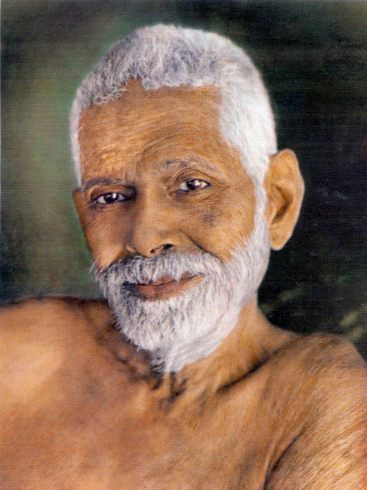
Om Namo Bhagavate Sri Arunachala Ramanaya
🕉️
SRI ARUNACHALA NAVAMANIMALAI - O COLAR DE NOVE GEMAS PRECIOSAS PARA ARUNACHALA, VERSÍCULO 5
sīrāṉa śōṇagiri śiṟakka vāṙuñ
ciṯsorupa ṉāmiṟaiyē siṟiya ṉēṉḏṟaṉ
pērāṉa piṙaiyellām poṟuttuk kāttup
piṉṉumivaṉ pāṙidaṉil vīṙā vaṇṇaṅ
kārāṉa karuṇaiviṙi koḍuppā yiṉḏṟēṟ
kaḍumbhavatti ṉiṉḏṟukarai yēṟa māṭṭē
ṉērāṉa duṇḍōtāy śiśuvuk kāṯṟu
niharaṯṟa nalaṉukku nihaṙttu vāyē.
Padacchēdam (separação das palavras): sīr āṉa śōṇagiri śiṟakka vāṙum cit-sorupaṉ ām iṟaiyē, siṟiyaṉēṉ taṉ pērāṉa piṙai ellām poṟuttu, kāttu piṉṉum ivaṉ pāṙ idaṉil vīṙā vaṇṇam kār āṉa karuṇai viṙi koḍuppāy. iṉḏṟēl, kaḍum bhavattiṉiṉḏṟu karai ēṟa māṭṭēṉ. nēr āṉadu uṇḍō tāy śiśuvukku āṯṟu nihar aṯṟam nalaṉukku? nihaṙttuvāyē.
Senhor que sois aquele cuja natureza é pura consciência, brilhando gloriosamente como o sublime Śōṇagiri, suportando todos os grandes erros de mim mesmo, esta pessoa mesquinha, e protegendo de tal forma que este não caia novamente em desolação, possais vós dar um olhar de graça, que é uma nuvem. De contrário, não serei capaz de me levantar na costa, de um nascimento cruel. Existe algo que é comparável ao bem inigualável que uma mãe faz por um filho? Possais vós dizer.
Paráfrase explicativa:
Senhor que sois cit-svarūpaṉ [aquele cuja natureza é pura consciência], brilhando gloriosamente como o sublime Śōṇagiri [a Montanha Vermelha, Aruṇācala], suportando [ou perdoando] todos os grandes erros de mim mesmo, esta pessoa mesquinha, e protegendo [me] de tal forma que este não caia novamente na desolação [de saṁsāra ou existência mundana], que possais vós dar [me] [vosso] olhar de graça, que está [sempre chovendo abundantemente como] nuvem [cheia de chuva]. Se não o fizer, não poderei levantar-me da costa do cruel [oceano de repetido] nascimento [e morte]. Dizei [me], haverá algo que se compare ao bem inigualável que uma mãe faz por [seu] filho? [Vós sois minha mãe e eu sou vosso filho, então cuidai bem de mim.]
✨

ॐ Arunachalam ॐ - Fotografia de Bernd Kalidas Flory
🕉️
VIDEO: 2021-08-16b Holland Park: Michael James fala sobre Śrī Aruṇācala Navamaṇimālai, versículo 5.
Este video começa com Sadhu Om a cantar o versículo 5 de ஸ்ரீ அருணாசல நவமணிமாலை ( Śrī Aruṇācala Navamaṇimālai), ‘O Colar de Nove Gemas Preciosas para Arunachala’, e em seguida Michael James reflete sobre ele e explica o seu significado e implicações.
youtube
🕉️
#Bhagavan Sri Ramana Maharshi#Michael James#Arunachala Stuti Panchakam#Cinco Poemas Em Louvor de Arunachala#Arunachala Navamanimalai#AN v.5#O Colar de Nove Gemas Preciosas para Arunachala#Arunachala#Sonagiri#Montanha Vermelha#pura consciência#oração#bhakti#devoção
0 notes
Photo
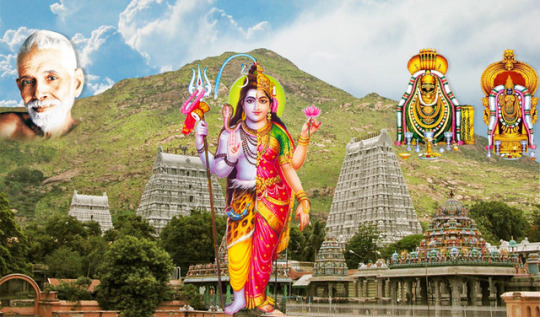
Holy Arunachala - Annamalai Hill - Arunachaleswarar or Annamalaiyar Temple, Lord Annamalaiyar (Arunachaleeswarar), and His consort Goddess Unnamlai (Apeethakuchalambal)
ॐ
Though Lord Siva is truly Achalan, the motionless one, in that assembly, at Chidambaram He dances in front of the Mother, Sakti Devi, who is Achalai, The consort of Achalan, in order to bring her dance to an end. But know that when that Sakti subsides in His motionless form here in Tiruvannamalai, He shines exalted as Arunachala.
ॐ
Bhagavan Sri Ramana Maharshi - Poems & Himns
Arunachala Navamanimalai - The Necklet of Nine Gems - G. 1, pg. 102
Note :
The word Achalan means the motionless one and is a name of Lord Siva which is used to denote the fact that He is the immutable, Supreme Reality.
The word Achalai means the consort of Achalan and is a name of Sakti, the Divine Mother.
Though He is motionless by nature, in Chidambaram Lord Siva had to dance in front of Sakti in order to bring Her frenzied dance to an end. But in the form of Arunachala Lord Siva remains ever motionless, and thus by the power of His mere stillness Sakti was irresistably attracted to Him and with great love she subsided in Him and became one with Him. Hence of all the forms of Lord Siva, Arunachala shines as the most exalted.
#Bhagavan Sri Ramana Maharshi#Poems & Himns#Arunachala Navamanimalai#AN v.1#Arunachala#Lord Siva#Achalan#holy mountain#hill of wisdom#Sakti#Achalai#immutable#Supreme Reality#Divine Mother#Arunachaleswarar or Annamalaiyar Temple#Lord Annamalaiyar or Arunachaleeswar#Goddess Unnamlai or Apeethakuchalambal
6 notes
·
View notes